The sun turns black, | earth sinks in the sea,
The hot stars down | from heaven are whirled;
Fierce grows the steam | and the life-feeding flame,
Till fire leaps high | about heaven itself.Völuspá (The Prophecy of the Witch) st. 57, Poetic Edda
536 AD: A volcanic eruption in Indonesia caused a global catastrophe. Even in Scandinavia did people experience the full blow of its aftermaths; the sun vanished from sight for three years – in its place were clouds of ash, a small Ice Age, famine and darkness, a winter lasting for three years. All this seems recognizable from Old Norse mythology, and it happened for real.
How did the people respond, asks the archaeologist Lena Fahre, whose lecture I went to see, what gave me some further inspiration for my books about the Oseberg women. Fahre emphasized the eruption and its consequences for Scandinavian culture; Just after this three year long winter – what the Norse referred to as “The Great Winter” (Fimbulvettr), Scandinavians, who had been used to a more pleasant and temperate climate than what now followed, began to perform large sacrifices and the building of great mounds.
Fast forward to 1904, when the great mound at Oseberg in Vestfold, Norway, was excavated. The archaeologists soon began to realize that they were about to dig out the Scandinavian equivalent of the grave of Tut Anch Amon – the greatest burial of the Viking Age. Grave robbers had removed the precious metals and jewelry, but even without these it was obvious that the grave belonged to a person so highly esteemed that one had to expect a great king, partly divine!
Great was the surprise, then, when the remains in the grave turned out to be two tiny old women. Quickly enough, the people back then decided that the burial must belong to that of Ása Haraldsdaughter of Agder, and her sacrificed handmaiden. This myth has lived on and is, despite thirty years of studies showing that it could not be, still represented as fact at the Vikingship museum in Oslo, where the Oseberg ship is at display.
Ása Queen was the daughter of Harald Granraudi (“Red Beard”), the king of Agder in western Norway. The king of Vestfold, Gudröd Hunter King, who also seems to have been a king or general of Denmark during the age of Charlemagne, launching an attack on the Franks in about 810 AD, wanted Ása for a wife, but her father refused his proposal. Then Gudröd came with an army, killed Harald and his son, and forcefully took Ása for a wife. She gave birth to Halfdan the Black around the year 810. Then she had her shoe-boy (an errand boy) murder her husband Gudröd, thus avenging her father and brother. According to the Frankish annals, Gudröd (Godofred) was murdered just as he arrived at the Frankish shores, and the Danish fleet saw this as a bad sign and did not attack that year. Ása returned to Agder where she ruled as queen and raised her son Halfdan. At the age of 18, Halfdan returned to Vestfold for his legacy, and came to father Harald Hair-Fair. The first archaeologists saw this as a national symbol: The grandmother of the man who united all the tribes of Norway in one kingdom for the first time ever had been given a great memorial.
Halfdan and Ása would have been contemporaries to the women who were buried at Oseberg, but all accounts show that Ása could not have died before 850 AD, and the Oseberg burial happened in the early autumn of 834 AD. Adding to that, it appears more and more obvious that both women held a high rank and that the second woman could not have been a simple servant maid. The rich contents of the grave lean more toward a religious cult than towards just royalty.
The grave consisted of a beautifully decorated oak-ship and a timbered burial chamber, one precious wagon, four sledges, picture tapestries, Persian blankets, 15 sacrificed horses, four dogs, one ox, and a lot of other items both practical and religious, and musical instruments. The ship itself had been constructed in the year 820 AD on the west coast of Norway, probably transported to Vestfold for the burial in 834 AD.
There are lots of things which could be said about this amazing, royal/religious/divine burial – but for now we shall focus on the two women who were laid there to rest, since DNA and other techniques now have been used to give us a far more detailed picture of their lives than we had before.
Who were they?
The two women, one aged between 70 and 80, the second about 50 years old, appear to have been originally placed together in the large matrimonial bed. Six single beds were also present in the grave, and it is entirely possible that these beds were also occupied by bodies. But during a grave robbery which we know happened 130 years later, in the 960s, these bodies, if they were there, may have been removed. Attempts to remove the two remaining skeletons somehow failed; several pieces of the youngest woman were left behind with the oldest woman, whose remains are almost complete. All jewelry was removed, possibly accounting for the mess in which the remaining pieces of the youngest woman´s skeleton was found.
We know, now, that both women were strong and that they had worked hard physically. But the way they had maintained very healthy teeth, used toothpicks, and eaten well, we may guess that they had a high rank in their lives. They ate mostly meat and very little fish. The most recent studies are even able to place the women; we know now that they must have spent a lot of time living in the eastern parts of Agder, the same kingdom that was ruled by Ása Queen, and where we know that the Oseberg ship was built.
One name we do have. On one of the precious buckets from Oseberg there is a runic inscription; “Sigrid owns (this bucket)”. Sigrid was a woman´s name and may have belonged to one of the women in the grave – whether it was one of the two we know of, or perhaps one of those who may have shared the grave, laid to rest in one of the single beds. This we do not know.
The Witch who Magically Transformed into a Man
The oldest woman in the grave, and the only one whose remains were almost complete, turned out to have been between 70 and 80 years old. She had suffered serious illness during her childhood and early youth. Then she may have moved on quite normally – but before reaching middle age, she began transforming.
She had a condition that we know as Morgagni Syndrome. It was a hormonal disease which caused some physical discomfort, which turned her bone structure very thick, probably she developed an indenture in her forehead, her jaws became broad, her shoulders massive, drowning her neck. Her voice became deeper, and her body hair grew – in fact she turned into a bearded woman. Her level of testosterone would have been as in a very masculine man.
Whatever inclinations she may have had before the condition changed her, she may very well have turned masculine in more ways than just appearance. Having been placed in a matrimonial bed together with another woman, archaeologists today must admit that they cannot outrule the possibility that the two women were a couple, although their relationship is completely unknown to us and could of course have many other possible explanations.
Archaeologists like Britt Solli have earlier pointed out the way this burial seems to belong to both the masculine and the feminine sphere, despite belonging to two women – a very unusual thing in Old Norse burials, although not unknown. Whenever the goods in a grave point to gender ambiguity, magic is usually involved.
There is also the issue of the possibility that at least six other people may have been buried with them. If they were women, they would have counted the magical number of eight, the exact number of main goddesses in Old Norse mythology.
Apart from being just 153 cm high, in an age where Scandinavian men could easily reach 180 cm, she would appear convincingly as if she was a woman who suddenly changed sex by some divine or magical decree.
To her contemporaries, the transformation must have seemed magical, even divine, and may actually account for her extreme importance. She may have already been a highly regarded person, a witch or a priestess, but this visible, apparent sex-change must have blown the minds of her contemporaries.
The oldest woman may have been the main character in this burial, the very heart of the ritual. She lived to a very old age for her time, and died of cancer – either ovarian or breast cancer, possibly a late result of her hormonal condition. Her back was crooked by the time of death, and she had suffered from a knee injury ten years before her death.
The Youngest Woman

Detail from Oseberg tapestry, a procession of women surrounded by serpents, floating above a Fly Agaric, carrying different items
The youngest woman in the grave was about 50 years old when she died. She had very healthy teeth and appears to have been healthy all over. A blow to her collar bone was for a long time considered evidence for how she may have been sacrificed. But now we know that this injury had begunto heal a long time before she died. The lack of skeleton pieces means that we do not know how she died. Since the oldest woman died of natural causes, it is very possible that the other(s) was (were) sacrificed as well, but we do not know.
The youngest woman was about 155 cm tall, quite short, but not uncommon for women of the Viking Age. The most interesting find about her, apart from having lived most of her adult life in east Agder, eating meat rather than fish, was that she had a maternal ancestry that was foreign. By mithocondrial descent, one of her direct maternal ancestors belonged to haplogroup U7. This maternal ancestry originated in the Black Sea area some 30 000 years ago and spread out – some came as far west as Germany, but most of the U7 descendants nowadays will be found in Iran, Pakistan, Afghanistan, India, Sri Lanka and western Siberia. This woman´s mother, or mother´s mother, or perhaps even far before that, would have been a foreigner from the east.
This fits well with my character Thordís, whose Baltic mother had a maternal ancestry from the Black Sea area.

The Oseberg Burial


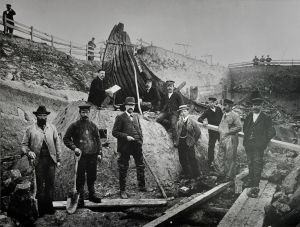











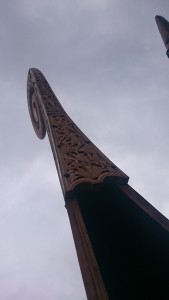






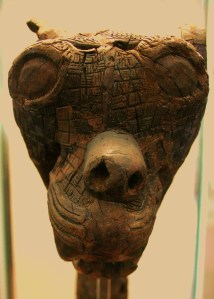

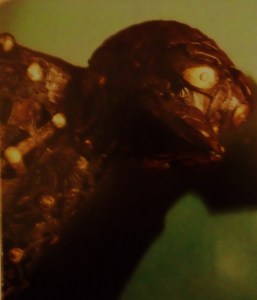










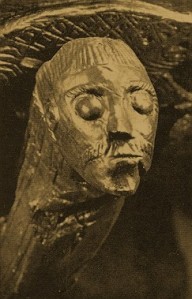

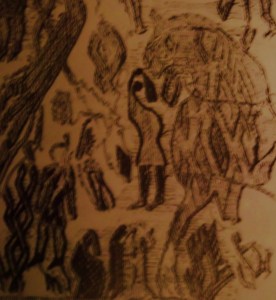



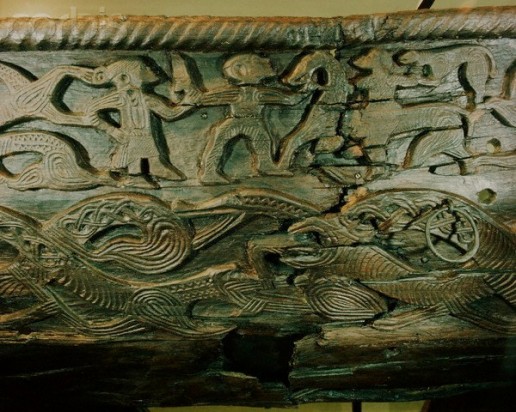


Pingback: The Bearded Woman of Oseberg | Tante Hilda
The sun turns black, | earth sinks in the sea,
The hot stars down | from heaven are whirled;
Fierce grows the steam | and the life-feeding flame,
Till fire leaps high | about heaven itself.
Völuspá (The Prophecy of the Witch) st. 57, Poetic Edda
It is likely that this is derived from older mythology and that it has nothing to do with the volcanic eruption of Indonesia in 536. It could just as well be from the Minoan eruption circa 1650 B.C. which would correlate with other myths of catastrophe around the globe.
Isaiah 24:1-20 King James Version (KJV)
24 Behold, the Lord maketh the earth empty, and maketh it waste, and turneth it upside down, and scattereth abroad the inhabitants thereof.
18 And it shall come to pass, that he who fleeth from the noise of the fear shall fall into the pit; and he that cometh up out of the midst of the pit shall be taken in the snare: for the windows from on high are open, and the foundations of the earth do shake.
19 The earth is utterly broken down, the earth is clean dissolved, the earth is moved exceedingly.
20 The earth shall reel to and fro like a drunkard, and shall be removed like a cottage; and the transgression thereof shall be heavy upon it; and it shall fall, and not rise again.
This excerpt from the Bibel is one of many that describes similar event taking place and the Bibel is just one of hundreds of myths containing catastrophe involving some of the following elements, black sun, red moon, dragons in the sky (asteroids, comets or planetary bodies), burning earth, bombardment of meteors, earthquakes, volcanic eruption, flooding and changing climates. It seems that these events have been an integral part of all humans history and mythology base. An event containing several or even all of these, by them self, catastrophic events, would make a an impression on the survivors so strong that it probably would evolve into religion/religious myth over generations. Just to pick on volcanic eruption, even a strong one like the one in Indonesia seems to be simplifying things to fit a theory. There have been strong volcanic eruption before and after Indonesia with similar results, like the Laki eruption of 1783. https://en.wikipedia.org/wiki/Laki
LikeLike
Thank you for sharing such fascinating research and insights!
LikeLike